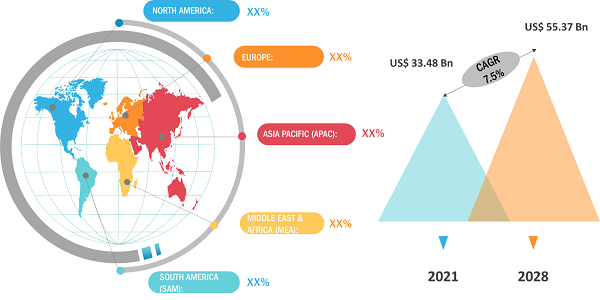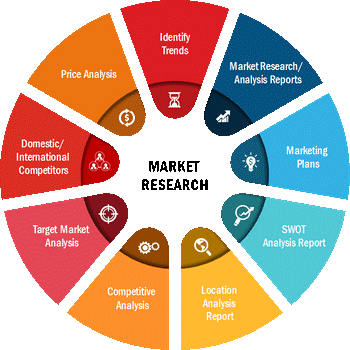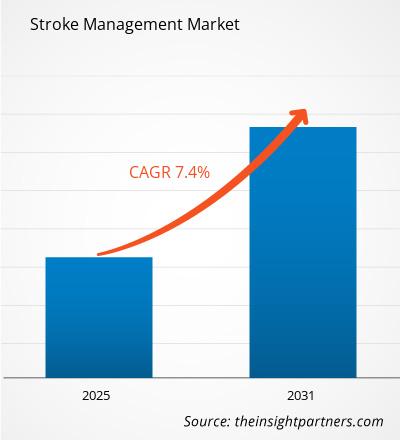Si prevede che il mercato della gestione dell'ictus crescerà da 33,48 miliardi di dollari nel 2021 a 55,37 dollari miliardi entro il 2031; si prevede che crescerà a un CAGR del 7,5% dal 2022 al 2031.
La crescente incidenza di malattie croniche, tra cui ipertensione, iperlipidemia e diabete, ha contribuito alla crescita del mercato della gestione dell'ictus. L’ipertensione è il principale fattore di rischio per l’ictus poiché una pressione sanguigna superiore a 140/90 mmHg può danneggiare i vasi sanguigni che forniscono sangue al cervello. Inoltre, il diabete è anche una delle principali cause di ictus. Secondo l’American Stroke Association, le persone con diabete hanno il doppio delle possibilità di avere un ictus e possono anche assistere all’insorgenza precoce dell’ictus. Inoltre, ogni due minuti, un adulto con diabete viene ricoverato in ospedale a causa di un ictus negli Stati Uniti, secondo gli stessi dati. Di conseguenza, i leader di mercato stanno lavorando per sviluppare trattamenti innovativi per l’ictus, e un’ampia varietà di nuovi farmaci e dispositivi sono allo studio per il trattamento e la diagnosi di tutti i principali tipi di ictus, e molti di essi dovrebbero ricevere l’approvazione nel settore. prossimo futuro. Ad esempio, nel settembre 2021, Johnson & Johnson ha annunciato il lancio di Cerenovus Stroke Solutions, che consiste in tre dispositivi in grado di assistere i medici nella rimozione dei coaguli. Inoltre, nell'agosto 2021, MicroTransponder Inc. ha ricevuto l'approvazione della FDA per Vivistim System, un sistema di riabilitazione per ictus primo nel suo genere, per il trattamento dei deficit motori degli arti superiori da moderati a gravi associati a ictus ischemico cronico.
DINAMICHE DEL MERCATO
< span style="font-family: verdana, geneva, sans-serif; font-size: 10pt;">La crescita del mercato della gestione dell'ictus è principalmente attribuita alla crescente prevalenza di disturbi cronici, al progresso tecnologico nella diagnosi e nella prevenzione dell'ictus. trattamento dell’ictus, aumento continuo del numero di consumatori di tabacco e aumento della popolazione geriatrica. Tuttavia, la lenta approvazione dei farmaci e gli enormi costi associati alle procedure coinvolte nel trattamento e nella diagnosi dell'ictus stanno ostacolando la crescita del mercato.
AMBITO DI MERCATO
L'analisi del mercato globale della gestione dell'ictus fino al 2031" Il rapporto mira a fornire una panoramica del mercato della gestione dell’ictus con una dettagliata segmentazione del mercato. Il rapporto fornisce statistiche chiave di mercato basate sulle prestazioni dei principali attori. Offre inoltre tendenze e opportunità chiave nel mercato.
Approfondimenti strategici
SEGMENTAZIONE DEL MERCATO
Il mercato globale della gestione dell'ictus è suddiviso in tipologia e applicazione. In base alla tipologia, il mercato è suddiviso in diagnostico e terapeutico. In base all'applicazione, il mercato è suddiviso in ictus ischemico e ictus emorragico.
Il mercato globale della gestione dell'ictus è segmentato in cinque regioni principali: Nord America, Europa, Asia Pacifico, Medio Oriente e Asia. Africa e Sud & America Centrale. Il rapporto copre l'analisi e le previsioni di 18 paesi in tutto il mondo insieme alle tendenze e alle opportunità prevalenti nella regione.
Il Nord America ha dominato il mercato della gestione dell'ictus con una quota di circa il 37% nel 2021. La crescita del mercato nella regione è principalmente attribuita alla presenza di un'enorme popolazione con disturbi cronici insieme alla presenza dei principali attori del mercato come Abbott Laboratories, B Braun Melsungen AG, Boston Scientific Corporation, Bristol Myers Squibb Co., Cardinal Health Inc. e General Electric Company. La figura seguente mostra il trend di crescita dei ricavi nel mercato della gestione dell'ictus in Nord America:
 Fonte: analisi dei partner Insight
Fonte: analisi dei partner Insight
Il rapporto analizza fattori quali fattori trainanti, vincoli, opportunità, e le tendenze future, che influiscono sul mercato della gestione dell’ictus. Fornisce inoltre un'analisi PEST esaustiva dei fattori che influenzano il mercato.
IMPATTO DELLA PANDEMIA DA COVID-19
L' La pandemia di COVID-19 ha comportato un aumento della domanda di farmaci per la gestione dell’ictus come Alteplase, Clopidogrel e Atorvastatina poiché la prevalenza dell’ictus è aumentata a causa della diffusione di SARS-CoV-2. Ciò ha portato ad un elevato volume di ordini tra i produttori di farmaci, con conseguente aumento del volume di produzione. Di conseguenza, il profitto dei prodotti di vari produttori di componenti farmaceutici è aumentato. Pertanto, l'approvvigionamento di componenti farmaceutici è aumentato durante la fase iniziale della pandemia, stimolando così la crescita del mercato globale della gestione dell'ictus.
La crescente consapevolezza sull'ictus ha comportato un improvviso aumento dei tassi diagnostici della malattia, che alla fine ha aumentato la domanda di farmaci mirati all'ictus come Ticagrelor, Alteplase e Clopidogrel. Gli attivatori tissutali del plasmogeno ricombinante rappresentano il trattamento più efficace per l'ictus ischemico e sono attualmente prescritti come trattamento di prima linea. Di conseguenza, è aumentato l'approvvigionamento di attivatori plasmogeni tissutali ricombinanti, il che sta rafforzando il mercato della gestione dell'ictus.
ATTORI DEL MERCATO
Il Il rapporto copre gli sviluppi chiave nel mercato della gestione dell’ictus. Diverse aziende si stanno concentrando su strategie di crescita organica, come lanci di prodotti, approvazioni di prodotti, brevetti ed eventi. Strategie di crescita inorganica come acquisizioni, partnership e collaborazioni hanno incoraggiato l’espansione del business e della base di clienti degli attori del mercato. Si prevede che gli operatori di mercato che operano nel settore della gestione dell'ictus sperimenteranno opportunità di crescita redditizie nei prossimi anni con la crescente domanda di trattamenti per l'ictus.
Il rapporto include anche i profili delle principali società di gestione dell'ictus, insieme alle loro analisi SWOT e strategie di mercato. Inoltre, il rapporto si concentra sui principali attori del settore con informazioni quali profili aziendali, componenti e servizi offerti, informazioni finanziarie negli ultimi tre anni e sviluppi chiave negli ultimi cinque anni. Di seguito è riportato l'elenco di alcune aziende impegnate nel mercato della gestione dell'ictus:
- •Abbott Laboratories•B Braun Melsungen AG•Boston Scientific Corporation•Bristol Myers Squibb Co.•Cardinal Health Inc.•General Electric Company•Glaxosmithkline Plc•Medtronic Plc•Merck And Co. Inc.•Siemens AG.
Il team di ricerca e analisi dedicato del partner Insight è composto da professionisti esperti con competenze statistiche avanzate e offre varie opzioni di personalizzazione nello studio attuale.

- Analisi storica (2 anni), anno base, previsione (7 anni) con CAGR
- Analisi PEST e SWOT
- Valore/volume delle dimensioni del mercato - Globale, regionale, nazionale
- Industria e panorama competitivo
- Set di dati Excel


- Hydrogen Storage Alloys Market
- Excimer & Femtosecond Ophthalmic Lasers Market
- Data Annotation Tools Market
- Pipe Relining Market
- Wind Turbine Composites Market
- Hydrocephalus Shunts Market
- Passport Reader Market
- Automotive Fabric Market
- Embolization Devices Market
- Bioremediation Technology and Services Market

Report Coverage
Revenue forecast, Company Analysis, Industry landscape, Growth factors, and Trends

Segment Covered
This text is related
to segments covered.

Regional Scope
North America, Europe, Asia Pacific, Middle East & Africa, South & Central America

Country Scope
This text is related
to country scope.
Domande frequenti
Hollister Incorporated, Nu-Hope Laboratories, Inc., ConvaTec Group PLC, ALCARE Co., Ltd., Flexicare Medical Limited, B. Braun Melsungen AG, 3M, Coloplast, Marlen Manufacturing and Development Company, Welland Medical Limited are some fo the major market players operating in the market
The ischemic stroke segment accounts for highest revenue in application sgement in 2023.
The Stroke Management Market is estimated to witness a CAGR of 7.40% from 2023 to 2031
Asia Pacific region dominated the stroke management market in 2023
North America region dominated the stroke management market in 2023.
The major factors driving the Stroke Management market are:
1.Rising Incidence of Stroke in Recent Times
2. Growing Awareness and Education
3.Favourable Government Policies and Regulations
Trends and growth analysis reports related to Life Sciences : READ MORE..
The List of Companies
1. Abbott Laboratories
2. B Braun Melsungen AG
3. Boston Scientific Corp.
4. Bristol-Myers Squibb
5. Cardinal Health
6. Medtronic Plc.
7. GlaxoSmithKline Plc.
8. GE Healthcare
9. Merck
10. Koninklijke Philips N.V.
The Insight Partners performs research in 4 major stages: Data Collection & Secondary Research, Primary Research, Data Analysis and Data Triangulation & Final Review.
- Data Collection and Secondary Research:
As a market research and consulting firm operating from a decade, we have published and advised several client across the globe. First step for any study will start with an assessment of currently available data and insights from existing reports. Further, historical and current market information is collected from Investor Presentations, Annual Reports, SEC Filings, etc., and other information related to company’s performance and market positioning are gathered from Paid Databases (Factiva, Hoovers, and Reuters) and various other publications available in public domain.
Several associations trade associates, technical forums, institutes, societies and organization are accessed to gain technical as well as market related insights through their publications such as research papers, blogs and press releases related to the studies are referred to get cues about the market. Further, white papers, journals, magazines, and other news articles published in last 3 years are scrutinized and analyzed to understand the current market trends.
- Primary Research:
The primarily interview analysis comprise of data obtained from industry participants interview and answers to survey questions gathered by in-house primary team.
For primary research, interviews are conducted with industry experts/CEOs/Marketing Managers/VPs/Subject Matter Experts from both demand and supply side to get a 360-degree view of the market. The primary team conducts several interviews based on the complexity of the markets to understand the various market trends and dynamics which makes research more credible and precise.
A typical research interview fulfils the following functions:
- Provides first-hand information on the market size, market trends, growth trends, competitive landscape, and outlook
- Validates and strengthens in-house secondary research findings
- Develops the analysis team’s expertise and market understanding
Primary research involves email interactions and telephone interviews for each market, category, segment, and sub-segment across geographies. The participants who typically take part in such a process include, but are not limited to:
- Industry participants: VPs, business development managers, market intelligence managers and national sales managers
- Outside experts: Valuation experts, research analysts and key opinion leaders specializing in the electronics and semiconductor industry.
Below is the breakup of our primary respondents by company, designation, and region:

Once we receive the confirmation from primary research sources or primary respondents, we finalize the base year market estimation and forecast the data as per the macroeconomic and microeconomic factors assessed during data collection.
- Data Analysis:
Once data is validated through both secondary as well as primary respondents, we finalize the market estimations by hypothesis formulation and factor analysis at regional and country level.
- Macro-Economic Factor Analysis:
We analyse macroeconomic indicators such the gross domestic product (GDP), increase in the demand for goods and services across industries, technological advancement, regional economic growth, governmental policies, the influence of COVID-19, PEST analysis, and other aspects. This analysis aids in setting benchmarks for various nations/regions and approximating market splits. Additionally, the general trend of the aforementioned components aid in determining the market's development possibilities.
- Country Level Data:
Various factors that are especially aligned to the country are taken into account to determine the market size for a certain area and country, including the presence of vendors, such as headquarters and offices, the country's GDP, demand patterns, and industry growth. To comprehend the market dynamics for the nation, a number of growth variables, inhibitors, application areas, and current market trends are researched. The aforementioned elements aid in determining the country's overall market's growth potential.
- Company Profile:
The “Table of Contents” is formulated by listing and analyzing more than 25 - 30 companies operating in the market ecosystem across geographies. However, we profile only 10 companies as a standard practice in our syndicate reports. These 10 companies comprise leading, emerging, and regional players. Nonetheless, our analysis is not restricted to the 10 listed companies, we also analyze other companies present in the market to develop a holistic view and understand the prevailing trends. The “Company Profiles” section in the report covers key facts, business description, products & services, financial information, SWOT analysis, and key developments. The financial information presented is extracted from the annual reports and official documents of the publicly listed companies. Upon collecting the information for the sections of respective companies, we verify them via various primary sources and then compile the data in respective company profiles. The company level information helps us in deriving the base number as well as in forecasting the market size.
- Developing Base Number:
Aggregation of sales statistics (2020-2022) and macro-economic factor, and other secondary and primary research insights are utilized to arrive at base number and related market shares for 2022. The data gaps are identified in this step and relevant market data is analyzed, collected from paid primary interviews or databases. On finalizing the base year market size, forecasts are developed on the basis of macro-economic, industry and market growth factors and company level analysis.
- Data Triangulation and Final Review:
The market findings and base year market size calculations are validated from supply as well as demand side. Demand side validations are based on macro-economic factor analysis and benchmarks for respective regions and countries. In case of supply side validations, revenues of major companies are estimated (in case not available) based on industry benchmark, approximate number of employees, product portfolio, and primary interviews revenues are gathered. Further revenue from target product/service segment is assessed to avoid overshooting of market statistics. In case of heavy deviations between supply and demand side values, all thes steps are repeated to achieve synchronization.
We follow an iterative model, wherein we share our research findings with Subject Matter Experts (SME’s) and Key Opinion Leaders (KOLs) until consensus view of the market is not formulated – this model negates any drastic deviation in the opinions of experts. Only validated and universally acceptable research findings are quoted in our reports.
We have important check points that we use to validate our research findings – which we call – data triangulation, where we validate the information, we generate from secondary sources with primary interviews and then we re-validate with our internal data bases and Subject matter experts. This comprehensive model enables us to deliver high quality, reliable data in shortest possible time.

 Ottieni un campione gratuito per questo repot
Ottieni un campione gratuito per questo repot